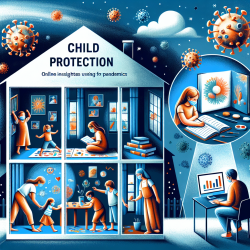Introduction
The COVID-19 pandemic has profoundly impacted various aspects of life, including child maltreatment and protective services. The research article "Two years into COVID-19: What do we know so far about child maltreatment in times of a pandemic and what else should be explored?" offers crucial insights into these impacts. As practitioners in the field of child protection, understanding these findings is vital to improving our practices and ensuring the safety and well-being of children during such crises.
Key Findings from the Research
The study by Katz et al. (2022) provides a comprehensive examination of child maltreatment reports and child protective service (CPS) responses in 12 regions globally, highlighting the varied impacts of the pandemic. Key findings include:
- Disruptions in CPS due to the pandemic were reported across all regions.
- Social, economic, and structural contexts significantly influenced CM reports and CPS responses.
- The pandemic exacerbated existing vulnerabilities, leading to increased risks for children.
Implications for Practitioners
Practitioners can leverage these insights to enhance their skills and adapt their approaches during pandemics:
- Understanding Contextual Influences: Recognize the role of social, economic, and structural factors in influencing child maltreatment and protective responses. Tailor interventions to address these factors effectively.
- Enhancing Telehealth Services: The shift to virtual interventions highlighted the need for robust telehealth services. Practitioners should focus on developing evidence-based telehealth interventions that ensure safety, confidentiality, and accessibility.
- Supporting Vulnerable Families: Families experiencing high levels of stress and violence need targeted support. Practitioners should be equipped to provide resources and interventions that address these challenges.
Encouraging Further Research
While the current research provides valuable insights, there is a need for ongoing exploration to fully understand the pandemic's impact on child maltreatment and protective services. Areas for further research include:
- Long-term effects of the pandemic on child maltreatment and protective services.
- Effective strategies for integrating telehealth into child protection practices.
- Developing interventions that address the unique needs of children with special educational needs during pandemics.
Conclusion
As practitioners dedicated to child protection, it is crucial to continuously adapt and improve our practices based on emerging research. The insights from the study by Katz et al. (2022) offer a valuable foundation for enhancing our approaches during pandemics. By understanding the contextual influences, enhancing telehealth services, and supporting vulnerable families, we can work towards better outcomes for children.
To read the original research paper, please follow this link: Two years into COVID-19: What do we know so far about child maltreatment in times of a pandemic and what else should be explored?










